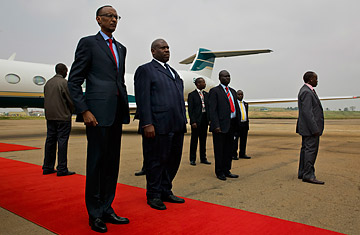
Uganda, Entebbe, 2012. President of the Republic of Rwanda Paul Kagame arrives in Uganda to take part in the a Great Lakes summit, joins the host President Yoweri Museveni, DRC's Joseph Kabila and other East African Head of State's, to discuss the insecuritues in Eastern Congo.
(3 of 5)
Kagame's response was, and remains, an adamant belief that Africa should determine its own destiny. His goal: true sovereignty and real freedom for Rwanda and, ultimately, Africa. He rejects the West's presumption of authority in Africa and the notion that underpins it — that the West somehow has a superior grasp of rights, politics, economics and human competence. It is a stance that manifests itself in a disdain of aid and the promotion of an enterprise economy that will, he predicts, wean his country off assistance in a decade; aggressive social improvements that, while assisted by outsiders, are designed and run by Rwanda; and a foreign policy that reserves Rwanda's right to pursue its enemies wherever they are.
But as convinced as he is of Africa's need for independent action, he is not, he says in a point-by-point rebuttal that lasts 42 minutes at our first meeting, guilty of backing the rebels in Congo and fueling war there. His critics say he is lying. Don't be misled by Kagame's painstaking response, says a U.N. official, whose contract forbids him from speaking on the record. Rwanda's long-standing plan, he says, is to foment chaos in eastern Congo, then be asked to intervene as a peacemaker. At which point Kagame will argue for an autonomous eastern Congo, which it plans to control for commercial and security reasons. If the recent flare-up shows anything, he adds, it's that the plan is working.
Rwandan Puppets?
Before I meet Kagame, I travel to eastern Congo to see for myself the rebellion he is accused of backing. I want to try to find evidence of Rwandan support and see the humanitarian disaster that aid workers are reporting.
As it has been through history, eastern Congo's population is a fluid mosaic of ethnicity; it includes scores of different Congolese tribes as well as ethnic Rwandese, Hutu and Tutsi. Many groups are related; just as many are enemies. It was into this volatile mix that hundreds of thousands of Hutu genocidaires and their families fled in 1994. The foreign aid operation to house and feed the fugitives was a lifeline for the Interahamwe, and soon they were attacking ethnic Rwandan villagers in Congo and Rwandan outposts over the border in Rwanda.
In response, Rwanda invaded Congo twice. "We were finding armored personnel carriers and antiaircraft guns in the camps," says Kagame. "And they were telling us these were just refugees." Years of war followed, costing millions of lives and pulling in several other African countries. Though most of those withdrew in 2003, anarchy remained. Today, Congo's President, Joseph Kabila, has barely any control over the east; if it is ruled at all, it is by an array of rival militias who mix ethnic allegiances and commercial interests with brutal criminality.
One of the strongest is the Tutsi-dominated CNDP (National Congress for the Defense of the People). In 2008 and '09, the CNDP staged a rebellion, captured a string of eastern towns and seemed poised to take Goma. Rwandan troops ended the crisis by entering Congo with Congolese permission, arresting CNDP leader Laurent Nkunda and persuading his replacement, Bosco Ntaganda, to integrate the CNDP into the national Congolese army.
The deal didn't hold. Ntaganda and the CNDP are now staging a second rebellion. This time they have named their movement M23, after the March 23, 2009, date of their integration deal with Kinshasa — on which they accuse the state of reneging. The mutineers have captured the same eastern towns as they did in 2009. For many observers, Rwanda's fingerprints are all over the rebellion. "They [Rwanda] were creating an inherently unstable situation," says Roger Meece, head of Congo's peacekeeping force, Monusco, through "a number of M23 leaders who have the most egregious human-rights record, including summary executions, using children and forced recruitment."
As I cross the border from Rwanda into Congo, I traverse a frontier from a new Africa into the old. Smooth roads, shopping malls and traffic policemen give way to a world of dirt tracks, grass-roofed huts and wooden bicycles, smoking volcanoes and jungles inhabited by gorillas and pygmies. Congo is unchanged in other ways too; it remains a source of as much of Africa's bloody darkness today as it was in Joseph Conrad's time.
For the next three days, I drive the length of M23 territory, interviewing rebels and villagers. Signs of fighting abound, from the charred skeleton of a Congolese army ammunition truck to village huts destroyed by artillery. One night, next to a roadside food stall where I am buying a plate of cassava and leaves, a shootout erupts. A man is killed, his body left in the street. A thief, I'm told.
But there is little sign of the calamity announced by foreign NGOs — nor, from what I see, many aid workers themselves, bar a single Red Cross team. Instead of starving refugees, I find lush fields of ripe sorghum, maize and potatoes, and giant plantations of coffee and bananas. Men in the villages near the fighting say their families still work the fields by day; at night, they sleep at a safe distance in a temporary camp. I check the refugee count with the U.N. They say the fighting has displaced 15,000 inside Congo and pushed 38,000 more into Rwanda or Uganda. The same day at a press conference in Goma, Oxfam's Congo director Elodie Martel says 500,000 people have been displaced since April and that "vast swaths of the east have descended into chaos with no government or security presence." An Oxfam Twitter message later claims more than 2 million people are displaced in Congo.
